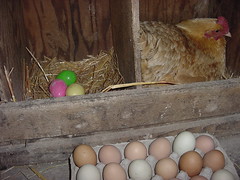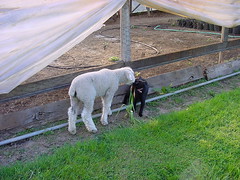
The question was this. "Do chickens see in color?" We hadn't been on the farm that long and it was an honest question. You would think Gisela and Dave and Janet and Nancy, all owners of chickens, might have known the answer, but they shook their collective heads. It had never come up, this question. Why did it matter if chickens could see the color of the worms they ate or the flowers they scratched out of neatly planted garden borders and window boxes? Even if they only saw in black and white the damage was the same. I sighed, mostly about the dead flowers.
I did ask the question with good reason. I thought I might have found a loop-hole in my newly acquired farming practices. We had inherited ten chickens when we moved to our farm and several of them had the bad habit of hiding their eggs. My mentor, Gisela, had shown me how to substitute white plastic eggs every time I raided the laying boxes in the chicken house. This made the hens think their nests were undisturbed, so they kept laying in the same place. The other option was to always leave an egg or two in the nest, marked with an 'x'. The next day the marked egg was removed and a newly laid egg marked.
Always remembering to carry a marker was a problem. The marking thing was not going to work. The plastic egg deception seemed reasonable, nothing like a little switcheroo as payback for the plants. Until the day my last fake-out either disappeared or was crushed underfoot. I don't remember the circumstances, but I did foresee a trip to the farm supply store for more plastic eggs.
Talk about sticker shock. The price of white plastic eggs was $1 a piece! I was remembering my city days when I was sure we had not paid more than $2 for an entire dozen plastic Easter eggs. This was rural living robbery! I coughed up for several of the fake eggs to tide me over ... until Easter, close to five months away. Since there was no consensus about chickens seeing in color, I figured if the chickens took exception to green, blue, pink and orange eggs, I could always dip them in some left-over white house paint from the workshop. For the first time, I was actually happy to see early merchandising in the grocery store for Easter, right after Valentine's Day.
In March, with the longer days that chickens like, the laying boxes on our farm were decorated with a myriad of pastel colored eggs. I decided to reserve the blue, green, and orange eggs for later, as they seemed a bit bright for the trial run. Would the gloom in the chicken house mask the pastels of the plastic? Did it even matter? Apparently not. The chickens laid where there were plastic eggs and they laid where there were none. In fact, it may not have mattered whether I had fake eggs in the boxes after all. The two wilder chickens with the bad habit of wandering off and reappearing with a brood of ten to twelve chicks had been killed the previous fall trying to defend them. The rest of the girls seemed perfectly happy to use the supplied boxes filled with clean straw.
I inherited new chickens this past winter. The colored plastic eggs have mostly been kicked from the nests and lie under piles of straw in the corners of the coop. Even the extras I took trouble to collect and place in egg cartons on a shelf in the coop have been scattered across the floor in some scuffle from the winter. It seems like years ago I wanted to know if chickens saw in color. In the end, it didn't really matter. We always had more eggs than we could eat, even when a hen or two would sneak off.
The Easter eggs are almost funny now too. I mean, I have a chicken that lays blue-green eggs all on her own! No plastic infusion molding technique. No need for dye tablets dropped in a glass of vinegar. No need to wait for Easter. But, beautiful, large, perfect blue-green eggs, standing out against the speckled browns, the light tans, and all varieties of eggs I collect each day. And, when you crack the shell, they look like any other farm-fresh eggs with the tell-tale rich yellow yoke of birds that free range on a diet of bugs and grubs mixed in for good measure.
These days I have a different question about chickens. "How do you keep them from jumping in the window boxes and scratching out the young, spring flowers? Spilling dirt across the entry way? Digging up perennials just peeking above the soil?" The chicken yard gate is shut; the fence has been scoured for holes. I guess it's time to sit out with a cup of coffee in the morning after feeding to find the way out ... and maybe use some of my extra, colored, plastic eggs for target practice!
All Rights Reserved. Copyright 2007 Scottie Jones
...Click here to read the rest of this post.
